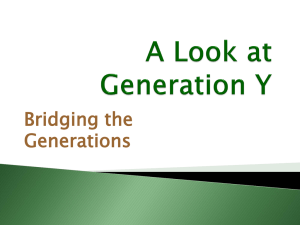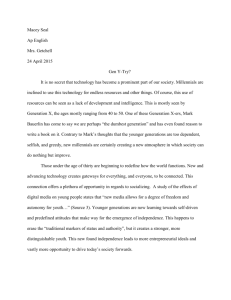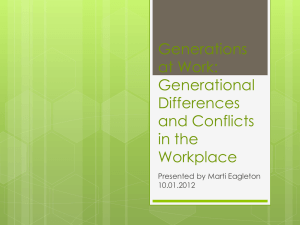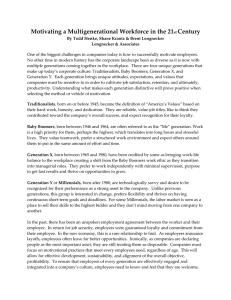We Are Bridges summary Dahvi Wilson, Associate, Commonweal Institute, and Fellow, Redefining Progress
advertisement
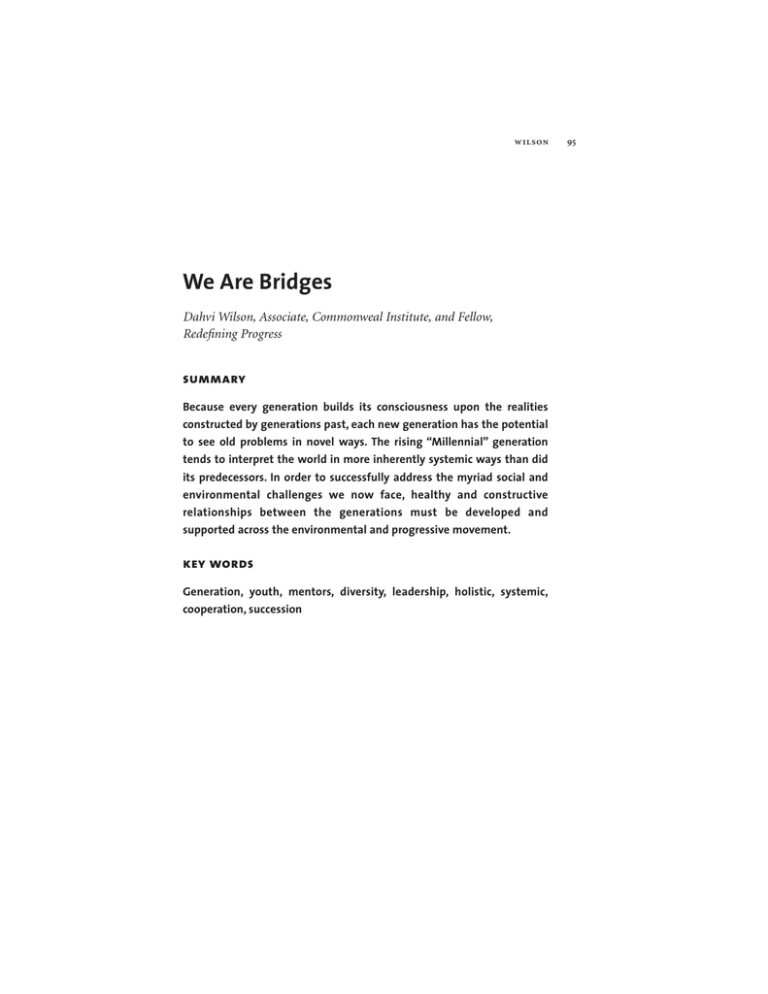
wilson We Are Bridges Dahvi Wilson, Associate, Commonweal Institute, and Fellow, Redefining Progress summary Because every generation builds its consciousness upon the realities constructed by generations past, each new generation has the potential to see old problems in novel ways. The rising “Millennial” generation tends to interpret the world in more inherently systemic ways than did its predecessors. In order to successfully address the myriad social and environmental challenges we now face, healthy and constructive relationships between the generations must be developed and supported across the environmental and progressive movement. key words Generation, youth, mentors, diversity, leadership, holistic, systemic, cooperation, succession 95 96 diversity and the future of the u.s. environmental movement My mind is not my own. It contains the wisdom of centuries. I did not invent the wheel or find the cure for polio, develop calculus or visit the moon, yet each of these breakthroughs exists in my cultural memory – bequeathed to me by my ancestors. Each of the giant leaps taken by a previous generation is present in the background of my thoughts. They are the foundation of my understanding and provide firm ground from which I may launch into inquiries never investigated before. None of us is born onto virgin ground. The discoveries of the past constitute the soil from which our social innovations grow and our cultural adaptations blossom. ~ I was born in 1979, nearly nine years to the day after the first Earth Day celebration. My mother and father, having been in college during the late 60s, entered their parental and professional lives riding the waves of the early environmental movement, the civil rights movement, the women’s movement, and the anti-Vietnam war movement. Theirs was an age of awakening, of introducing American society to concepts and battles that had long been ignored or underappreciated. Along with other members of their generation, they demanded that certain longneglected entities, individuals, and social groups be granted consideration, protection, and rights under the law. They fought to sharpen the contrasts between society as it had come to be accepted, and society as it could be; to point out and relish difference. They showed us that different was beautiful, but that separate was not generally equal. They forced their nation to question long-held assumptions about women, people of color, and the reliability of government. They rallied to bring new focus and clarity to issues that had long been blurred into the background. Much of the progress of the 1960s was based upon drawing new lines and shouting for the recognition of the groups these new boundaries distinguished. By the time I was born, the “environment” was no longer a novel or particularly abstract notion, and the idea of forced segregation in schools seemed inconceivable. I was able to attend a college that had only accepted men a few decades before, and my graduating classes in both college and graduate school were about 55 percent female. The battles my parents fought paved the path upon which I would walk, barely able to comprehend life as it had existed before, and without a doubt, taking their victories for granted. wilson Concepts that were unheard of when my parents were growing up were commonplace in my childhood. They became everyday aspects of my generation’s cultural literacy. Arising in the social consciousness during my most formative years were such diverse topics as the Internet, AIDS, climate change, institutional racism, and globalization. Ideas like these laid the backdrop for my mental development. Their existence made me different, in a very fundamental way, from my parents, just as the rise of television, rock and roll, and the iconic walk of Neil Armstrong had made them different from theirs. In fact, every generation is different. As Dan King, Principal and CEO of the training firm Career Planning and Management, Inc. writes: Much like sexuality, gender, ethnicity and race, a generational identity distinguishes each of us. Imprinted by major experiences and events – like Pearl Harbor, the JFK assassination, the Challenger explosion – a generation’s shared identity shapes the values, ethics, and attitudes about the world in which its members live and work.1 Arising in the social consciousness during my most formative years were such diverse topics as the Internet, AIDS, climate change, institutional racism, and globalization. Ideas like these laid the backdrop for my mental development. Their existence made me different, in a very fundamental way, from my parents, just as the rise of television, rock and roll, and the iconic walk of Neil Armstrong had made them different from theirs. Such distinctions have led those who study inter-generational interaction2 to identify four primary, contemporary generations: the 1 2 King, Dan. 2000. “Defining a Generation: Tips for Uniting Our Multi-Generational Workforce.” Career Planning and Management, Inc.: Boston. <http://www.careerfirm.com/generations.htm>. The thesis that each generation has a unique identity has become popular fodder for business management consultants and conflict resolution specialists. Some other authors on the subject include Neil Howe, William Strauss, Carolyn Martin, Claire Raines, Ron Zemke. 97 98 diversity and the future of the u.s. environmental movement Traditionalists – quiet, compliant, and thrifty children of World War II; the Baby Boomers – rebellious children of the 1950s and 60s; the Generation Xers – survivors of rising divorce rates, the material indulgence of the 1980s, and the spread of AIDS; and the Millennials – optimistic, over-therapied children of the Internet age. Each ageclass builds its conceptions of reality upon the shoulders of those who came before, allowing succeeding generations to reach unprecedented new vantage points. Because each generation starts from a new set of base assumptions, each is able to bring new perspectives and contributions to their communities. Intuitively, they develop their own unique ways of perceiving, interpreting, and addressing challenges both in the workplace, and in society more broadly. Because each generation starts from a new set of base assumptions, each is able to bring new perspectives and contributions to their communities. Intuitively, they develop their own unique ways of perceiving, interpreting, and addressing challenges both in the workplace, and in society more broadly. This natural evolution of thought bridges the past and the future, and allows for adaptation, creativity, and advancement. With each new generation comes a new energy and the potential to break out of the boxes of assumptions in which older generations have been imprisoned. We have so much to learn from each other. Just as older generations are invaluable to the pursuit of progress for their experience, wisdom, and knowledge of institutional history, younger generations are invaluable for their fresh sight and vision. With their new eyes, they hold the power to perceive new solutions to old problems and to continue the pursuits of those before them. ~ A few autumns ago, I was granted an invitation to participate in a dialogue-based, “Mentors and Apprentices” retreat, hosted by The Center for Whole Communities – an organization focused on wilson exploring, honoring, and deepening the connections between land, people and community.3 The Center is housed at Knoll Farm, a beautiful organic farm and gathering place in the hills of northern Vermont with a long history of social activism. As described in the retreat materials, the point of the gathering was: . . . to practice a different exchange or transition between those at different points in their careers in the land movement. With the increased specialization and professionalism of the land movement, we’ve nearly lost the tradition of passing wisdom along to a younger generation in a deep and meaningful way. We will create space for honest and open dialogue on core issues about right livelihood, equity and fairness, and how best to live and act in this modern world.4 For several days, about twenty of us gathered for meals, hikes, meditations, and dialogues about the state of the modern environmental movement. We discussed the threats facing our society and the global community, and our hopes and fears for the future. The mentors participating in the gathering were incredible role models – leaders whose work and passion assured those of us just getting started of the positive change we could affect in the world. As exciting as it was to sit beside them, the retreat was a relatively somber affair. Though care was taken to ensure that our conversations were punctuated with occasions for joy and celebration, the weight of the work to be done rested heavy upon our shoulders, dark and heavy like the heavy fog that blanketed the still green hillsides every morning. There were five of us Millennials present, but the retreat had been designed and run by Boomers, and the effects were obvious: the Boomers were in mourning. Frustrated and discouraged by the ultimate results of their generation’s revolutions, the Boomers felt lost. They believed that they had failed, that all of the vision and passion for a better world that fueled their earlier years had fizzled away in the seductive onslaught of mass consumption and middle-age wealth seeking. They feared that they had left a broken and corrupted world to their children, and they 3 4 The Center for Whole Communities Mission Statement. To learn more, visit http://www. wholecommunities.org. Forbes, Peter. Letter to participants in Mentors and Apprentices Retreat. 2005. 99 100 diversity and the future of the u.s. environmental movement could see no way out. They realized, somewhere deep within themselves, that the problems they had left behind would likely not be solved within their lifetimes. They were starting to lose hope. As the nature of the process began to reveal itself, we five Millennials began to experience frustrations of our own. Sensing the conversations stalling around questions of what had gone wrong and where we had lost our way, the Millennials were left unsatisfied. We had little use for meditating on what wasn’t; we were too full of energy to explore what could be. We were just beginning our professional lives, full of big dreams for our futures; we did not need to mourn the failures of the past. Our eyes were focused on the vital and vibrant future, a future very much alive. We understood that old ways of seeing had run their proponents into dead-ends. What had been a critical new vision forty years ago had reached the limits of its capacity. The world we were hoping to create could not be simply “environmentally friendly,” solely “socially just,” or purely “economically sound.” It had to be all of these things. As we discussed the issue with each other, we realized that all five of us seemed to share the same intuitive notion about how to forge a new path. It seemed simple, so obvious in fact, that we began to refer to it as “the duh factor.” We realized that none of the social problems we had come to discuss in the retreat were independent of each other. All were connected. Just as the loss of any single component of an ecosystem can unravel the delicate balance maintained there, so too can the loss of any single issue in a larger suite of progressive ideals similarly disintegrate our dreams for a more perfect world. The world we were hoping to create could not be simply “environmentally friendly,” solely “socially just,” or purely “economically sound.” It had to be all of these things. We realized that we could no longer remain locked up in old, fragmented ways of thinking. While our elders were discussing how to maintain hope, we were living it. We explored ideas about crossing boundaries, about learning to understand each other and speak each wilson others’ languages, and the possibilities of helping organizers increase their familiarity with each other across traditional issue lines. We were considering the nexus of economics, social justice, environmental sustainability, health, and human welfare, on a domestic and international scale. We came to understand the new sight our generation would bring to the world. We would be bridges. What we didn’t realize until the retreat was over was that within our youthful spirit and faith, we also had the potential to embody the hope our elders needed. Though the retreat was intended to be an equal meeting place of the younger and the older, traditional dynamics of influence subtly remained and prevented some of this mutual bolstering from taking place. Had they but surrendered themselves completely to the future for a moment, freed themselves from their privileged positions of knowledge and wisdom, envisioned themselves as enablers rather than teachers, then all of us might have left the retreat a little more fulfilled. This experience taught me, more potently than anything before it, that mentors are not simply responsible for passing information down, but that they are a critical force in raising new ideas up – nurturing, strengthening, and applying these novel notions in the present day. Turning these dreams into reality is something we can only do together. We Millennials need their support to build our confidence, grant us legitimacy, and help us incorporate lessons from the past into our thinking, and the Boomers need us to remind them that the future is not dead yet, and to assure them that the noble work will continue. ~ Every generation makes great strides, and every generation grows so proud of the contributions it makes that its members become convinced that their answers are the only answers, forgetting that every generation before them once felt the same. However, history is a constant exchange of tradition, knowledge, and power from one generation to the next. We need to nurture the wisdom that each generation brings in order to continue our cultural development. It should be the duty and pleasure of an outgoing generation to welcome in the next. Unfortunately, in America, the Boomers who still make up the leadership of most of the nation’s social non-profits, have been slow 101 102 diversity and the future of the u.s. environmental movement to turn over control to their successors. In 2005, an organization called Building Movement published a monograph that summarized the findings of a three-year study they conducted, “investigating the differences between older and young people working in progressive social change organizations.”5 The report titled, “Up Next: Generation Change and the Leadership of Nonprofit Organizations,” offers many interesting insights about the variations between different generations of individuals working together for social change. Among them was the realization that: As the Baby Boomers edge into their 50s and 60s, nonprofit organizations will soon be making room for a new generation of leaders. The sector as a whole, however, has only just begun to anticipate the shift of this older leadership cohort – directors, boards, staff members – who grew up with organizations founded in the 1960s and 1970s. . . . The realization that Baby Boom leaders will be leaving their jobs in the next decade has begun to send shockwaves through the nonprofit sector . . . The Boomers described their difficulty in finding and grooming young leadership, and their frustrations with what they saw as the younger generation’s unwillingness to ‘pay their dues’ and work their way up within organizations. Younger people described the lack of support for the next generation of leadership . . . . Few older leaders could imagine leaving their organizations and worried about who would carry on their work.6 I believe that the tendency of the Boomer generation to hold on so tightly to their power and control has hindered them, their successors, and the movement as a whole. By stifling new styles of operating, new ideas, and new ways of addressing the problems we face as a society, the Boomer generation has severely handicapped its ability to innovate and adapt to the new reality. Rather than “working their way up” the traditional ranks of the old organizations, many young people are dropping out to form their own organizations, only to find themselves in stiff financial and ideological competition with their more entrenched elders. The demographics of the 5 6 Kunruether, Frances. 2005. “Up Next: Generation Change and the Leadership of Nonprofit Organizations.” Baltimore: The Annie E. Casey Foundation.: 6. Ibid.: 2,5. wilson major environmental groups reflect this trend, as the majority of their dues paying members continue to be over fifty years old.7 Recognizing this, the major environmental groups are constantly grasping for new media and “hip” brand images to attract younger constituents. While many, if not all, of these organizations pay significant lip service to the need to engage youth, few are willing to trust young people in leadership roles.8 It might behoove these organizations to consider turning over more of their leadership to the next generation – establishing a close advisory team of elders to support and mentor these new leaders, but giving them the freedom to shape their own paths. I believe that the tendency of the Boomer generation to hold on so tightly to their power and control has hindered them, their successors, and the movement as a whole. By stifling new styles of operating, new ideas, and new ways of addressing the problems we face as a society, the Boomer generation has severely handicapped its ability to innovate and adapt to the new reality. In fact, doing so might also strengthen the movement. As noted in the 2003 United Nations World Youth Report: The fact remains that as movements and their activists age there is always need for renewal from the grassroots, or even for the creation of alternative movement forms and foci . . . [Numerous] examples illustrate how a new generation of young people [have] identified the need for a response and invented new forms of activism.9 ~ We are reaching a moment in modern history when new solutions are desperately needed. Old strategies of organizing, educating, and 7 8 9 “Toward a New Ecological Majority.” American Environics. http://www.americanenvironics.com/ PDF/Road_Map_for_Ecological_Majority_AE.pdf. Accessed on the World Wide Web: May 7, 2007. <http://www.americanenvironics.com/Files_Publications/Road_Map_for_Ecological_ Majority_AE.pdf> I believe that the Sierra Club may stand out as an exception to this trend. World Youth Report 2003: The Global Situation of Young People. Chapter 5. New York: United Nations Publications. 2003: 137. <http://www.un.org/esa/socdev/unyin/wyr03.htm> 103 104 diversity and the future of the u.s. environmental movement communicating are proving incapable of addressing such immense global problems as climate change, species extinction, the everincreasing income disparities between rich and poor, and the rise of a global corporate oligarchy. Luckily, the Millennials are coming at these problems from a new angle. Unlike the Boomers who built their social movements in an era of differentiation, Milliennials have emerged during a historical moment in which nearly every field of science has begun to turn toward systems-level, relational thinking. The study of ecology has brought the science of interconnection to the field of biology. Quantum physics and relativity have taught us the fundamental importance of relationships in understanding space and time. The social sciences have taught us to be distrustful of absolutes and to consider political, ecological, economic, and social contexts before assessing other cultures and historical events. Studies of human wellbeing have begun to demonstrate that human fulfillment may be determined, in large part, by healthy relationships with others and strong community life. Now, the rising significance of relationships in our social consciousness has birthed a generation of individuals who more intrinsically seek relational, holistic explanations of the world around them. It is only a matter of time until the “duh factor” inevitably alters the way the social movements of the future operate. We are reaching a moment in modern history when new solutions are desperately needed. Old strategies of organizing, educating, and communicating are proving incapable of addressing such immense global problems as climate change, species extinction, the ever-increasing income disparities between rich and poor, and the rise of a global corporate oligarchy. Whereas the Boomers continue to build outreach strategies that focus on specialization within specific issue areas, I believe the Millennials are intuitively drawn to the interconnections between issue areas. As “Up Next” confirms, wilson . . . Younger participants were particularly struck by the inability of different groups to work together. They expressed frustration that the larger social change goal was subverted by individual ‘ego’ needs.10 As a result of this frustration, I predict that the solutions Millennials envision will be far different from those of their predecessors. While the Boomer’s movements may have worked to build social awareness about different challenging issues in the 1960s and 70s, the Millennials’ movements will seek to cultivate the synergies that emerge when traditional issue-based advocacy groups, once disconnected from each other, unite around their common goals and values. The next generation of social movements will employ coalitions, coordination, and cooperation to create solutions capable of addressing our systemic problems holistically. As clearly captured by one participant in Building Movement’s “Generational Leadership Listening Sessions:” We need to build more partnerships, look around to action and take an active interest in what other people are doing. And not just pretend we’re the only ones doing this work. We need to look forward in unexpected places. We need to open our arms . . . to really build a movement that includes everyone.11 My mind is not my own. I am humbled by the knowledge that the cultural soil upon which I tread has been built up, torn down, and built up again perpetually by those who have come before me. My world is built upon a mountain of former discoveries, insights, and ideas, a formation of cultural wisdom and history. Every generation finds its footing on the discoveries of the past, and uses this foundation to leap into new dimensions of thought, understanding, and innovation. It is a beautiful progression, deeply innate in us and natural, but to truly nurture this progression, we must strive to be bridges between past and future worlds. It is the duty and challenge of every generation 10 11 Ibid.:10. Kunreuther, Frances, Ludovic Blain, and Kim Fellner. 2004. “Generational Leadership Listening Sessions.” New York: Building Movement Project. <http://www.buildingmovement.org/artman/uploads/glls_report_001.pdf>: 39. 105 106 diversity and the future of the u.s. environmental movement to build communities, organizations, and institutions that support and value healthy interaction among age cohorts; structures strong enough to span time and experience; and enduring enough to lead us, eternally, into a hopeful future. about the author Dahvi Wilson graduated Magna Cum Laude from Brown University in 2001 with a degree in Environmental Studies. She received her Masters of Environmental Management degree from the Yale School of Forestry & Environmental Studies (F&ES) in 2007. Her professional experience includes air quality planning and policy development with the California Air Resources Board, teaching and curriculum design with the Teton Science Schools, facilitation and leadership work with The Murie Center, coordination and outreach with the Yale F&ES Office of Strategic Initiatives, and nearly ten years of guiding wild rivers. She is a student of progressive politics, a steering committee member for the Next Generation Retreat of the Center for Whole Communities, an Associate of the Commonweal Institute, and a Fellow of Redefining Progress. dahvi.wilson@aya.yale.edu

